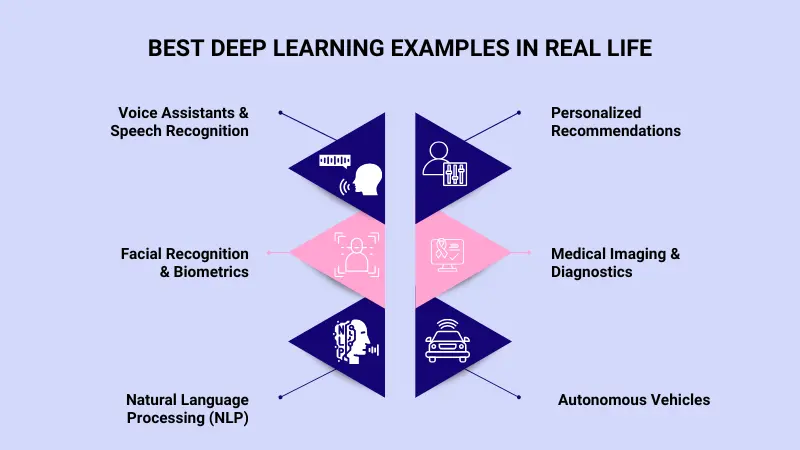If you have ever wondered how Netflix recommends your next binge-worthy series, how Siri understands your voice, or how self-driving cars recognize stop signs, you are already seeing deep learning in action.
And deep learning in artificial intelligence (AI) is quietly transforming the way we live, work, and interact with technology.
But what is deep learning, really? And why is everyone from startups to tech giants racing to invest in it?
According to Grand View Research, the global deep learning market is projected to reach a staggering $526.7 billion by 2030. That’s a clear signal of how this AI subfield is quickly shaping the tech world.
Looking to learn more than just deep learning basics?
Here’s a deep learning tutorial for beginners where you will understand what deep learning is, how it works, and why it matters more than ever.
Let’s quickly get started!
An Overview of Deep Learning
Deep learning is basically a form of machine learning that uses artificial neural networks to gain knowledge from previous datasets. These neural networks are designed to work just like human brains to interpret data and solve complicated problems.
The main aim of deep learning models is to identify images, speech, text, and other complex data forms. It also makes it easier to get a better grip on the data, which gives us more insights and helps us make predictions.
The neural network layers are designed from interconnected nodes. Each of the layers is responsible for receiving inputs, processing them, and generating an output, which is then passed on to other nodes. Well, that’s a simple explanation of how deep learning works!
Want a step-by-step explanation? Check out the next section!
How Does Deep Learning Work Step-By-Step?
Now, let’s understand the steps involved in how deep learning works!
Data Collection
Deep learning begins with data. This could be images, text, audio, or any other kind of input. Let’s say you want to teach a deep learning model to identify cats. For that, you will need thousands of labeled pictures of cats and non-cats.
Similar techniques are used by AI developers to train models for automation, data analytics, and intelligent decision-making systems.
Data Preprocessing
Raw data usually needs to be prepared before it can be used for model training. It needs to be cleaned, organized, and sometimes converted into a numerical format that a machine can understand.
Building a Neural Network
At the heart of deep learning is the neural network, a system of layers made up of artificial “neurons.” These networks are called “deep” because they have a ton of layers.
There are three main types of layers:
- Input Layer: Receives the data (e.g., pixels from an image).
- Hidden Layers: These do most of the processing through weighted connections.
- Output Layer: Produces the final prediction (e.g., “cat” or “not cat”).
Forward Propagation
Here’s where the data flows through the network:
- Each neuron takes inputs from the previous layer.
- It calculates weights to help the network learn complex patterns.
- The result moves to the next layer cat”).
- This continues until the network produces an output.
Loss Calculation
Once the model makes a prediction, it compares it to the actual result. The difference between the two is called the loss or error. This tells the model how far off it was and is crucial for learning.
Backpropagation & Optimization
To improve accuracy, the model adjusts its internal parameters, such as:
- Backpropagation sends the error backward through the network.
- The model adjusts its weights to minimize future errors by using algorithms such as gradient descent.
- The model is refined through several iterations of adjustments and reassessments until it reaches a satisfactory level of accuracy.
Model Evaluation
After training, the model is tested on new, unseen data to check how well it performs. This helps figure out how well it really performs. This step helps avoid overfitting.
Deployment
Once the model performs well, it can be deployed into real-world applications like voice assistants, recommendation systems, autonomous vehicles, and more.
Difference Between Deep Learning (DL), Machine Learning (ML), and AI
With deep learning explained, you might still be wondering how it actually differs from machine learning and artificial intelligence. Let’s clear up the confusion once and for all!
| Aspect | Artificial Intelligence (AI) | Machine Learning (ML) | Deep Learning (DL) |
| Definition | The broad concept of machines simulating human intelligence. | A subset of AI that enables machines to learn from data. | A subset of ML that uses neural networks to learn from large datasets. |
| Goal | Mimic human thinking and decision-making | Learn patterns from data and improve automatically | Learn and extract features from complex or unstructured data. |
| Data Requirement | Can work with smaller datasets. | Needs moderate amounts of data. | Requires large volumes of data. |
| Algorithms Used | Rule-based systems, decision trees, etc. | Linear regression, decision trees, SVM, KNN. | Convolutional Neural Networks (CNNs), Recurrent Neural Networks (RNNs). |
| Examples | Siri, chatbots, game-playing bots, and smart home systems. | Email spam filters, fraud detection, and product recommendations. | Self-driving cars, facial recognition, voice assistants, and image generation. |
Popular Deep Learning Algorithms & Models
The below-mentioned are some of the common types of deep learning techniques that are being applied across different systems today:
Feedforward Neural Networks (FNNs)
FNNs are deep learning models in which information flows only forward. This means from the input layer through the hidden layer to the output layer. It is one of the simplest and earliest DL models that is also known as deep networks, neural networks, and multilayer perceptrons.
Convoluted Neural Networks (CNNs)
CNNs activate the nodes in the network when the output of such nodes exceeds the threshold. They basically use convolutional layers to identify hierarchical arrangements. This makes it good for tasks such as object detection, image recognition, and face recognition.
Recurrent Neural Networks (RNNs)
RNNs are easily adaptable to natural language processing (NLP) and speech recognition because of their preference for sequential data. It is known for its deep learning applications such as stock market predictions, sales forecasting, language translation, and more.
Generative Adversarial Networks (GANs)
GANs are a specialized type of deep learning technique that consists of two different networks, that is, a generator and a descriptor. It creates new data that resembles the original training data and can also be used to train the ML model.
Transformer Models
Transformer models in deep learning are capable of processing input sequences in parallel, which further requires less training time than RNNs and CNNs. For example, ChatGPT uses this transformer model to answer questions, summarize texts, and make predictions.
Best Deep Learning Examples in Real Life
Below are some of the deep learning uses in everyday life:
Voice Assistants & Speech Recognition
Deep learning algorithms enable virtual assistants like Siri, Alexa, and Google Assistant to comprehend and respond to voice commands. These systems utilize neural networks to understand natural language and improve over time by learning from user interactions.
Facial Recognition & Biometrics
Facial recognition systems in security and personal devices rely on neural networks to spot and recognize facial features accurately. Airports, law enforcement agencies, and smartphone manufacturers widely use this technology for authentication and identification.
Natural Language Processing (NLP)
Deep learning powers many advanced NLP applications, which is one of the emerging AI technologies. It includes real-time language translation, sentiment analysis, and AI-driven chatbots. Google Translate uses deep learning to provide accurate language processing.
Personalized Recommendations
E-commerce and streaming platforms like Amazon, Netflix, and Spotify use deep learning to analyze user behavior and preferences. These models generate highly personalized product or content recommendations.
Medical Imaging & Diagnostics
In the healthcare sector, deep learning is widely used. Its algorithms are designed to analyze medical images, which include X-rays, MRIs, and CT scans. Some of the applications include early detection of cancer, neurological disorders, and retinal diseases.
Autonomous Vehicles
Self-driving cars use advanced technology for object detection, lane tracking, traffic sign recognition, and decision-making in real-time. Neural networks use data from cameras and sensors to navigate safely in complex environments.
The Future of Deep Learning
Deep learning is now transforming several industries like healthcare, finance, and entertainment, and its future is even more promising. Let’s explore deep learning future trends in 2025!
Explainable AI (XAI)
Deep learning models are called “black boxes” because they make decisions without revealing the reasoning behind them. That’s the strength of Explainable AI (XAI). It’s all about making deep learning systems easier to understand, more transparent, and more reliable.
Quantum Deep Learning
Quantum apps are still in their early stages, but they hold massive potential to supercharge deep learning models. It has the ability to resolve issues faster than traditional computers, handle massive datasets with greater efficiency, and reveal groundbreaking opportunities in fields such as drug discovery, encryption, and complex simulations.
Robotic Process Automation (RPA)
Deep learning is transforming Robotic Process Automation (RPA), which automates repetitive tasks like data entry and invoice processing. RPA was traditionally used for managing structured data and following specific rules. Deep learning enables RPA bots to understand unstructured data and make better decisions based on past actions, resulting in more efficient workflows.
The End Note
That brings us to the end of this blog!
Deep learning is now becoming a vital part of everyday life and business. Considering real-life deep learning examples, one thing is clear: it is shaping the future of technology.
But you know what’s really exciting? We are just getting started! We are only in the early chapters of this whole thing. As the tools become more powerful and accessible, the opportunities for innovation are limitless.
If you are looking to explore how DL can elevate your business or tech idea, the experts at Technoloader are here to help you!
 +91 7014607737
+91 7014607737
 info@technoloader.com
info@technoloader.com




